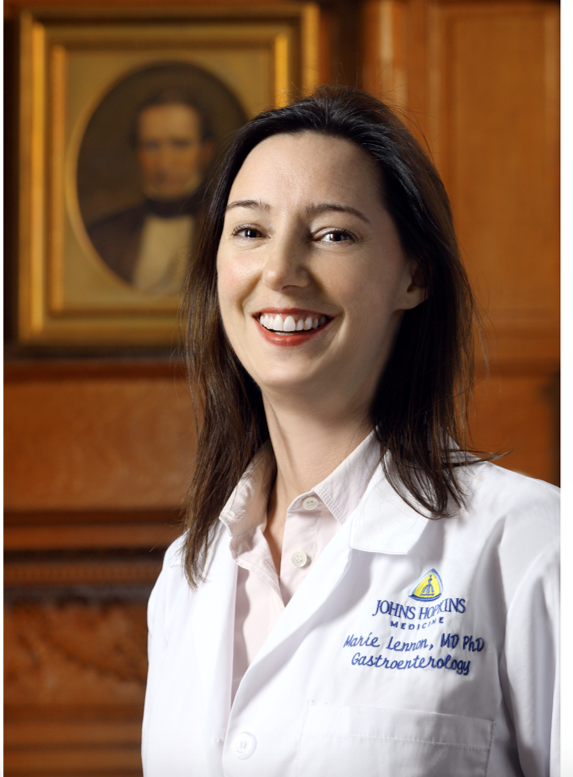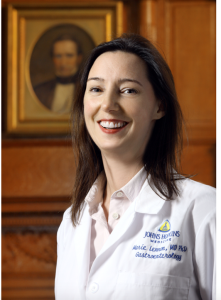Study Advances Potential Test To Sort Precancerous Pancreatic Cysts From More Harmless Benign Cysts

Release Date: November 17, 2015
By Johns Hopkins Medicne
In a “look-back” analysis of data stored on 130 patients with pancreatic cysts, scientists at Johns Hopkins have used gene-based tests and a fixed set of clinical criteria to more accurately distinguish precancerous cysts from those less likely to do harm. The findings may eventually help some patients in real time safely avoid surgery to remove harmless cysts. A report on the findings is published in the November issue of Gastroenterology.
Currently, doctors must test fluid collected from a needle that penetrates the cyst during a procedure called an endoscopic ultrasound-guided biopsy. The fluid is tested for levels of proteins associated with cancerous cysts, and pathologists look for atypical cells signifying cancer. However, recent studies show that these current methods are accurate only 63 percent of the time, says Anne Marie Lennon, M.D., Ph.D., associate professor of medicine at the Johns Hopkins University School of Medicine and director of the Multidisciplinary Pancreatic Cyst Program.
Building on preliminary gene tests the scientists developed in 2011 that measure the presence of pancreatic cancer-linked genetic markers in cyst fluid samples, the Johns Hopkins-led team expanded the panel of genetic markers and tested them on cyst fluid from 130 patients who had surgery to remove cysts at The Johns Hopkins Hospital and 16 other hospitals in the United States and other countries.
In addition to using genetic-based markers, the scientists developed a mathematical model that identifies various types of pancreatic cysts and their potential for malignancy by taking into account patient characteristics such as age and symptoms, as well as appearance and location of the cysts, based on medical record information from 1,026 patients who had surgery to remove cysts at The Johns Hopkins Hospital.
“The combination of genetic tests and clinical evaluation of patients’ cysts may change the way we guide patients on whether surgery to remove cysts is necessary,” says Lennon.
To evaluate the validity of the new combination approach, the Johns Hopkins-led team performed genetic tests on the cyst fluid samples and evaluated clinical criteria of the 130 patients.
They were able to identify 12 benign cysts called serous cystadenomas with 98 percent specificity, an indication, they say, of how often a test accurately identifies a disease, and 100 percent sensitivity, a measure of accuracy in correctly identifying people without a disease.
The scientists identified 10 cysts called solid-pseudopapillary neoplasms, which, doctors say, should be surgically removed, with 89 percent sensitivity and 92 percent specificity. Their tests also identified 12 mucinous cystic neoplasms, which doctors often remove, with 97 specificity and 90 percent sensitivity.
Finally, the Johns Hopkins team identified 96 of the more common intraductal papillary mucinous neoplasms with 94 percent sensitivity and 84 percent specificity. The low- and intermediate-risk varieties of these cysts are often monitored carefully when patients have no symptoms. When the malignancy risk level is high, doctors recommend surgical removal.
In the United States, Lennon says, doctors find pancreatic cysts in approximately 2.6 percent of people who undergo computed tomography scans, usually for nonspecific symptoms, such as chronic pain, injury or infection, and 3 to 13.5 percent of people who undergo magnetic resonance imaging scans. Based on U.S. population statistics for people age 65 and older, this amounts to more than 1 million people who may face uncertainty about the malignant potential of a pancreatic cyst. Currently, Lennon says approximately 665,600 new pancreatic cysts are identified via CT scan each year in the United States.
Some harmless cysts should be removed because of their large size or tendency to cause swelling in the organ or jaundice, but Lennon estimates that more than 20 percent of surgically removed pancreatic cysts thought to be cancerous are later found to be benign.
“Most people who are evaluated for pancreatic cysts are older adults in their 60s and 70s and have comorbidities that can make surgery more risky,” says Lennon. “We want to avoid unnecessary surgery whenever we can.” The complications include fistulas, infections, and some deaths, which also occur.
The researchers caution that, 40 percent of the time, doctors are unable to collect enough cyst fluid for standard analysis, a problem they say their genetic testing method solves by requiring only very small samples of cystic DNA. But they caution that cyst fluid removal is not risk-free and can cause bleeding, infection and inflammation in a very small percentage of patients.
To determine whether DNA changes present in the cyst could be accurately detected before surgery, Lennon and her colleagues compared genetic tests on cyst fluid samples obtained during endoscopic ultrasound before surgery and from cyst specimens surgically removed in 24 of the 130 study subjects. They found a similar number of genetic changes in 21 of the samples before surgery and 20 of the surgically removed cyst specimens.
“Our study shows that our expanded panel of genetic markers, combined with clinical acumen, can accurately differentiate between types of pancreatic cysts and identify cysts that are safe to watch over time and cysts that need to be removed,” says Ralph Hruban, M.D., Baxley Professor in Pathology and director of the Pathology Department for the Johns Hopkins University School of Medicine and director of the Sol Goldman Pancreatic Cancer Research Center.
“Correctly identifying whether pancreatic cysts pose a high risk for malignancy is key to preventing an often deadly cancer, or avoiding a needless surgery for cysts not likely to be a problem,” says Bert Vogelstein, M.D., Clayton Professor of Oncology and director of the Ludwig Center at the Johns Hopkins Kimmel Cancer Center. He was also a co-author of the study.
Lennon says the team plans to study the combination approach on more varieties of pancreatic cysts, especially the rarer types. To further validate the findings, they must test the approach on larger numbers of patients, determine how well the approach identifies cysts that need to be removed in newly-diagnosed patients, and evaluate its cost effectiveness.
Other scientists who contributed to the research include Simeon Springer, Yuxuan Wang, Marco Dal Molin, David Masica, Yuchen Jiao, Isaac Kinde, Amanda Blackford, Siva Raman, Christopher Wolfgang, Tyler Tomita, Noushin Niknafs, Christopher Douville, Janine Ptak, Lisa Dobbyn, Peter Allen, David Klimstra, Mark Schattner, Michael Goggins, Marcia Irene Canto, Nita Ahuja, Kenzo Hirose, Martin Makary, Matthew Weiss, John Cameron, Meredith Pittman, James Eshleman, Luis Diaz Jr., Nickolas Papadopoulos, Kenneth Kinzler, and Rachel Karchin from Johns Hopkins; C. Max Schmidt from Memorial Sloan-Kettering Cancer Center; Michele Yip-Schneider and Oscar Cummings from the University of Indiana; Randall Brand, Herbert Zeh and Aatur Singhi from the University of Pittsburgh; Aldo Scarpa, Roberto Salvia, Giuseppe Malleo and Giuseppe Zamboni from the University and Hospital Trust of Verona, Italy; Massimo Falconi from the IRCCS San Raffaele Scientific Institute, Milan, Italy; Jin-Young Jang, Sun-Whe Kim and Wooil Kwon from the Seoul National University College of Medicine, Seoul, Korea; Seung-Mo Hong, Ki-Byung Song and Song Cheol Kim from the Asan Medical Center, University of Ulsan College of Medicine, Seoul, Korea; Niall Swan, Jean Murphy and Justin Geoghegan from St. Vincent’s University Hospital, Dublin, Ireland; William Brugge, Carlos Fernandez-Del Castillo and Mari Mino-Kenudson from Massachusetts General Hospital; Richard Schulick and Barish Edil from the University of Colorado; Volkan Adsay from Emory University; Jorge Paulino from Centro Hepatobiliopancreático e Transplantação – Hospital Curry Cabral, Lisbon, Portugal; Jeanin van Hooft from Amsterdam Medical Center, Netherlands; Shinichi Yachida, Satoshi Nara and Nobuyoshi Hiraoka from National Cancer Center Hospital and National Cancer Center Research Institute, Tokyo, Japan; Kenji Yamao and Susuma Hijioka from the Aichi Cancer Center Hospital, Nagoya, Japan; and Schalk van der Merwe from University Hospitals KU Leuven, Belgium.
Funding for the study was provided by the Lustgarten Foundation for Pancreatic Cancer Research, the Sol Goldman Center for Pancreatic Cancer Research, the Virginia and D.K. Ludwig Fund for Cancer Research, Susan Wojcicki and Dennis Troper, The Michael Rolfe Foundation, the National Institutes of Health’s National Cancer Institute (CA62924), the Associazione Italiana Ricerca Cancro (12182) Italian Ministry of Research (FIRB RBAP10AHJB) and Health (FIMP J33G13000210001).
Diaz, Papadopoulos, Kinzler and Vogelstein are founders of Personal Genome Diagnostics Inc. and PapGene Inc. Vogelstein and Kinzler are also members of the Scientific Advisory Board of Syxmex-Inostics. These companies and others have licensed technologies from the Johns Hopkins University, of which Diaz, Hruban, Klein, Goggins, Papadopoulos, Kinzler and Vogelstein are inventors and receive royalties from these licenses. The terms of these arrangements are being managed by the university in accordance with its conflict of interest policies.

